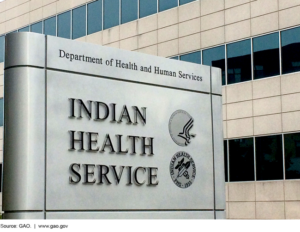
- Details
- By Rear Adm. Michael D. Weahkee
I’m proud of everyone across the Indian health system working tirelessly to provide American Indians and Alaska Natives with access to high-quality health care. I believe we are all united by a strategic vision: healthy communities and quality health care systems through strong partnerships and culturally responsive practices.
IHS’ 2019 accomplishments are the result of robust collaboration between the IHS team, tribes, tribal and urban Indian organizations, and our partners across government, academia, and non-governmental organizations.
To establish long term goals for quality implementation and outcomes, the IHS developed a five-year (2019-2023) Strategic Plan. The plan promotes a culture of accountability, quality, and patient safety across the agency.
We formally established the IHS Office of Quality to provide national leadership and promote consistency in health care quality across the agency. The IHS has made significant strides in addressing priority areas for quality improvement including implementing credentialing and privileging software agency-wide; hiring an IHS credentialing program manager at headquarters; and awarding a new contract for an adverse events reporting and tracking system. Some of our other quality improvement efforts include:
- In 2019, 97% of all IHS hospitals received Centers for Medicare and Medicaid Services certification.
- Eighty-seven percent of eligible ambulatory care facilities and 36% of hospital-based ambulatory care clinics held Patient-Centered Medical Home recognition through The Joint Commission or the Accreditation Association for Ambulatory Health Care.
- The Rosebud IHS Hospital achieved accreditation by The Joint Commission in November 2019.
- The Pine Ridge IHS Hospital was surveyed in December 2019 by CMS as part of the process to regain certification.

We supported efforts to address the opioid crisis by releasing clinical recommendation on neonatal opioid withdrawal syndrome and for healthcare providers treating American Indian and Alaska Native pregnant women and women of childbearing age. IHS released Recommendations for Management of Acute Dental Pain to assist dentists in selecting the safest pain control options.
This year, we played a major role in the new “Ending the HIV Epidemic: A Plan for America” initiative, which is leveraging powerful data and tools now available to reduce new HIV infections in the U.S. by 75 percent in five years and by 90 percent by 2030. With funding from the Department of Health and Human Services Minority HIV/AIDS Fund, IHS supported HIV and hepatitis C activities in IHS, tribal, and urban Indian healthcare settings around retention in care, outreach and education, treatment, prevention, and clinical training.
- IHS awarded $1.5 million to the Cherokee Nation for an Ending the HIV Epidemic pilot project.
- IHS provided $2.4 million to enable Tribal Epidemiology Centers to strengthen public health capacity of tribal, urban Indian organizations, and intertribal consortia in developing or accelerating Native-specific community plans to end the HIV epidemic in Indian Country.
- IHS released a new Special General Memorandum - Hepatitis C: Universal Screening and Treatment that expands screening for the hepatitis C virus to all IHS patients over the age of 18 years at least once in their lifetime, with additional risk-based screening as indicated.
While American Indians and Alaska Natives continue to experience higher rates of diabetes than any other racial or ethnic group, significant improvements have been made. A May 2019 report from the HHS Office of the Assistant Secretary for Planning and Evaluation reported that a 54% decrease in the incidence of diabetes-related end-stage renal disease in Native populations likely resulted in thousands fewer cases and hundreds of millions of dollars in savings to Medicare.
IHS also strengthened policies and new training to protect patients from abuse. New professional standards and stronger requirements for IHS employees to report suspected sexual abuse and exploitation of children were implemented nationwide. As part of this new policy, Protecting Children from Sexual Abuse by Health Care Providers, in June, IHS announced the availability of employee training on protecting children from sexual abuse in health care settings and made the training mandatory for all IHS staff members.
IHS initiated, continued or completed funding for all remaining health care facility construction projects on the 1992 grandfathered priority list. In addition, IHS awarded $15 million to eight tribes for the Small Ambulatory Program, and issued a new solicitation for Joint Venture Construction Projects. In September, the Indian Health Service awarded a design-build contract to a Native American owned company for the new Rapid City Health Center in South Dakota. The 200,000 square foot primary care facility will employ over 500 personnel and will be constructed on the existing Sioux San Campus in Rapid City. The new facility will include primary and specialty care, diagnostic imaging, laboratory, pharmacy, behavioral health, and preventive services.
IHS is committed to making improvements and ultimately to being removed from the Government Accountability Office’s High Risk list. Although IHS is still on the list, we have made significant progress. GAO cited 14 open recommendations in the High Risk Reports. Of those 14 recommendations cited in the High Risk Reports, GAO closed 11 recommendations.
As we plan for 2020, we remain committed to our mission of raising the physical, mental, social, and spiritual health of American Indians and Alaska Natives to the highest level. I have great confidence that the IHS team will deliver results for American Indians and Alaska Natives across Indian Country.
More Stories Like This
Native News Weekly (August 25, 2024): D.C. BriefsUS Presidents in Their Own Words Concerning American Indians
Native News Weekly (December 7, 2025): D.C. Briefs
Breaking: Final Defense Legislation Grants Federal Recognition to Lumbee Tribe
Why We Report: Chez Oxendine Shares His Story for Native News Online’s Year-End Campaign
Help us defend tribal sovereignty.
At Native News Online, our mission is rooted in telling the stories that strengthen sovereignty and uplift Indigenous voices — not just at year’s end, but every single day.
Because of your generosity last year, we were able to keep our reporters on the ground in tribal communities, at national gatherings and in the halls of Congress — covering the issues that matter most to Indian Country: sovereignty, culture, education, health and economic opportunity.
That support sustained us through a tough year in 2025. Now, as we look to the year ahead, we need your help right now to ensure warrior journalism remains strong — reporting that defends tribal sovereignty, amplifies Native truth, and holds power accountable.
 The stakes couldn't be higher. Your support keeps Native voices heard, Native stories told and Native sovereignty defended.
The stakes couldn't be higher. Your support keeps Native voices heard, Native stories told and Native sovereignty defended.
Stand with Warrior Journalism today.
Levi Rickert (Potawatomi), Editor & Publisher
